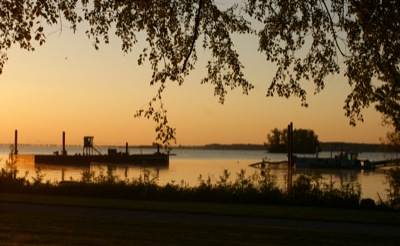Thursday, May 10th, 2012
Toxic algae level already high in lake
By Nancy Allen

Photo by Shelley Grieshop/The Daily Standard
The statewide Eagle dredge, right, sits in Grand Lake off West Bank state park land this morning. It will work most of this summer removing sediment from the mouth of Coldwater Creek. At left is the state park's barge, which is being used as a wind break to protect the dredge from wave action.
GRAND LAKE - Blue-green algae toxin levels in Grand Lake already are more than 20 times higher than they were last year at the same time. Blame the weather, officials say.
Samples taken near Celina's water intake pipe show the levels for microcystin - a liver toxin - were 46.4 parts per billion (ppb) on April 12 and 46.2 ppb on April 18. Last year they were 2.3 and 0.4 ppb in corresponding weeks.
"So much of that is weather related, and it got so warm in March," Ohio EPA spokeswoman Dina Pierce said. "It's the warmer weather that usually causes it to start blooming."
Pierce said she could not say whether the recently completed, $5 million lake alum treatment will lower toxin levels; alum is meant to target and deactivate phosphorous, algae's main food source.
"It doesn't directly affect toxin levels, it affects the phosphorous levels, which can ideally reduce the amount of blue-green algae," she said.
Microcystin levels fluctuated throughout 2011, dipping as low as 0.2 ppb in March to a high of 43.4 ppb in June.
The state's protocol for harmful algae blooms is posting an orange advisory sign on state water bodies if toxins exceed 6 ppb and warning the elderly, very young and people with compromised immune systems not to swim or wade in the water. A red advisory sign is posted when toxin levels exceed 20 ppb and there are one or more probable cases of human illness or pet deaths from algae toxins.
Scott Fletcher, ODNR spokesperson, said water samples will be taken from the three public beaches on Grand Lake about a week before Memorial Day, the traditional kickoff to the recreational season.
New this year, permanent algae signs with photos and blue-green algae information will be put at Grand Lake's beaches and state boat launch areas, as well as 13 other lakes in Ohio that have had toxic algae blooms. Those signs go up next week.
The lake's second alum treatment in two years, meant to combat algae blooms, ended April 30.
The state applied alum to the roughly 4,900-acre center of the lake and used about 1 percent more chemicals than last year. The state spent $3.4 million for the treatment in 2011.
Documents from the state show the cost for alum increased 35 percent from last year, and the price of sodium aluminate, a buffer that keeps pH levels even so fish aren't harmed, rose 24 percent. The state this year also hired a prime contractor, Donahue Ideas LLC, and a consultant, Tetra Tech.
HAB was the sole contractor last year. Tetra Tech provided services in 2011, but the state didn't pay for it because the firm was on loan from the U.S. EPA.
Fletcher, who was the project manager for last year's treatment, said the state hired Donahue because it also wanted the licensed engineering firm to study algae blooms at two other lakes - Wingfoot Lake near Akron and Burr Oak Lake near Athens.
Columbus-based Donahue is a qualified engineering firm in Ohio, while Lincoln, Neb.-based HAB is not, he said.
"So it included doing other than just putting alum on (Grand Lake)," Fletcher said. "We wanted a well-qualified firm with expertise investigating water quality issues."
None of the $5 million for this year's alum treatment was used to study blooms at the other two lakes, Fletcher said, adding that $50,000 was allocated from parks operating funds for that purpose.
- Algal toxin monitoring results can be found online at
www.epa.state.oh.us/dsw/HAB.aspx.



